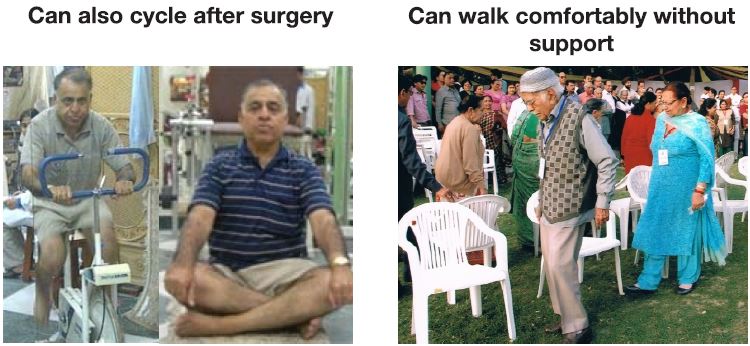65 year old female undergone bilateral TKR done in 2005. Presented to us with c/o pain in left knee with inability to bear weight over left lower limb and was wheel chair bound for the past 5 months .
On examination skin condition was normal , no sign of inflammation with mild effusion Varus instability present with Passive Rom 10 to 120 degree
Current xray shows tibial tray subsidence with loosening with varus collapse of proximal tibial bone Blood infection markers were within normal limits.
Plan for revision TKR left knee. Intraop medial defect was found on tibial side with uneven tibial surface after removal of the component Femur side component was also found to be loose with ligamentous imbalance. So RHK revision TKR was performed using medial half block on tibial side to augment the defect with stem extension and while on femur side normal component with stem extension used and inserted with cement.
After the surgery, the deformity of knee has been corrected and balanced and she has regained full and stable range of movement. She is walking comfortably.
Revision Knee Replacement Surgery Types of Artificial Knee Joints
How long do Artificial Knees last?
Surgeons and manufacturers have made remarkable advances in jointreplacement technology over the last few years. The materials are long lasting and durable. The surgical methods have been fine tuned and standardized. As a result, the chances for a successful outcome are excellent.
The operation will provide pain relief for at least 10-15 years. The majorlong term problem is loosening of the prosthesis. This occurs because either the cement crumbles (as old mortar in a brick building) or thebone loosens away (resorbs) from the cement. By 10 years, 25% of totalknee replacements may look loose on X-ray, and about 10% will be painful and require reoperation. By 15 years possibly 20% may requirere-operation.
These complications are more likely in very obese or hyper active people and really depends upon how careful you are about your artificialknee joint.
What are the benefits of Knee Joint Replacement?
Once your new joint has completely healed, you will reap the benefits of the surgery.
These include:
Reduced joint pain dramatically (may be no pain)
Increased movement and mobility
Correction of deformity
Improved quality of life – the ability to return to normal activities
Running, jumping, jogging or other high impact activities arediscouraged. However, you can resume playing golf, walking, bicycling, swimming and other low impact sports


Is there any age consideration for Knee Replacement?
Although knee joint replacement is recommended in older age group, it can be considered in younger patients who are severely crippled due torheumatoid arthritis or post traumatic osteoarthritis of knees. As such, age is no bar to this operation.
Can I continue with all these disabilities?
Yes you can, but your unstable joints may cause a fall and you may have fractures around the knees and the hips because of osteoporotic bones.
Regular consumption of analgesics and anti-inflammatory drugs may damage your kidneys and cause ulcers in your stomach.

